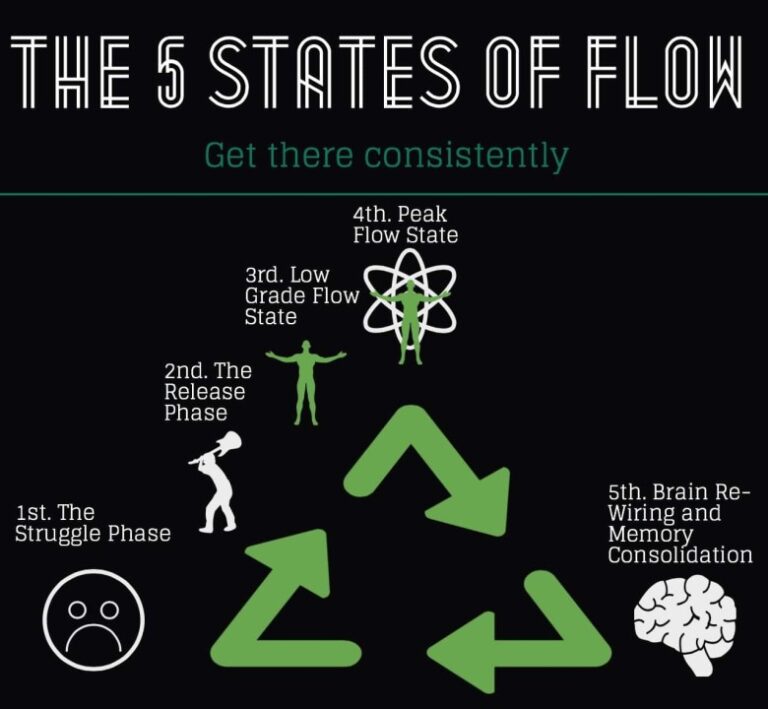
Unlocking Peak Performance: Cue-Based Training and the Path to Flow State
By Ken Cherryhomes
Preface
In this article, the captivating world of flow state and its profound impact on athletic performance is explored. While cue-based training is a focus of the discussion, it’s important to note that achieving flow state is not limited to a single method. Cue-based training is just one tool among many that can help individuals unlock their potential and experience the transformative benefits of flow. The intention is to shed light on the power and significance of flow state itself, independent of any specific training methodology. Flow state, also known as ‘being in the zone,’ is a state of complete immersion, effortless concentration, and heightened performance that transcends any particular training method. Readers are encouraged to approach this article with an open mind, recognizing that cue-based training is merely one pathway among many towards flow state. By understanding the concept of flow state, individuals can explore different approaches and find the techniques that resonate with them as they embark on their own journey to unlock peak performance. So let us delve into the captivating world of flow state, where optimal performance, creativity, and the joy of athletic endeavor intersect. Discover the potential that lies within, regardless of the specific methods employed, and embrace the transformative possibilities that flow state offers.
xFactor Technology and Cue-Based Behavior Training
As a developer of a multi-patented cue-based training technology specifically designed for baseball batters, I aim to revolutionize skill acquisition and game performance. The objective of this innovative training method is to enhance batters’ timing decisions for bat swings, accelerating batter timing skill acquisition by removing mental obstacles that can hinder the batter. Current training protocols are limited to trial/error learning that requires guessing. This is a slow and often frustrating methodology. By providing cues and signals for decision-making tasks, this approach simplifies the cognitive process and reduces stress and thought distractions. By introducing a precisely timed signal, cue-based training provides athletes with clear and focused guidance, allowing them to concentrate their attention and achieve optimal performance. Once the cue is removed, the behavior (timing memory) remains, enabling batters to make instinctive, informed decisions and potentially enter a state of effortless concentration without the distraction of problem-solving.
With mental barriers removed, athletes can unlock flow state and experience heightened performance and seamless execution on the field. By incorporating cue-based training of behaviors and lowering the brainwave state to an almost meditative state, we can accelerate skill acquisition and facilitate better game performance. Not only this, but the focus is also on eliminating the mental obstacles that make it challenging for batters to enter the coveted flow state.
What is the Flow State?
Flow state, popularized by Hungarian-American psychologist Mihály Csíkszentmihályi, is the brainwave state characterized by selflessness, timelessness, effortlessness, and richness. In the realm of athletics, flow state is commonly known as “being in the zone” and refers to a mental state of complete immersion and focus in an activity. It is characterized by effortless concentration, heightened performance, and a loss of self-awareness.
Flow state offers significant benefits for athletes, enhancing their overall performance and enjoyment of the sport. Athletes in flow state often experience heightened awareness, improved decision-making, and a seamless connection between their actions and desired outcomes.
One of the key aspects of flow state lies in the synchronization of brainwave patterns. Research suggests that during flow, the brain enters a state of focused attention, striking a balance between alpha and theta brainwaves. Alpha waves are associated with relaxed yet alert states, while theta waves are linked to creativity and deep concentration. This synchronization of brainwave patterns contributes to the enhanced cognitive abilities and effortless performance experienced during flow state.
Athletes can cultivate flow state by engaging in activities that match their skill level with the level of challenge presented. Finding the optimal balance is crucial, as low challenge levels may result in boredom and disengagement, while high challenge levels can lead to feelings of being overwhelmed and anxious. Techniques such as goal-setting, visualization, mindfulness, and deliberate practice can further assist athletes in achieving and maintaining flow state. By fully immersing themselves in the present moment and managing distractions, athletes increase the likelihood of experiencing flow and unlocking their peak performance potential.
Let’s explore the stages of the flow state journey. It begins with the initial struggle, where we face challenging tasks or problems. This stage evokes feelings of frustration, difficulty, and stress. The presence of adrenaline and cortisol raises our heart rate, blood pressure, and prepares our body for a stressful situation. During this phase, our brainwaves are in the beta range, typically between 12-40 Hz, reflecting active mental engagement.
After a period of struggling, we reach the release stage. It becomes essential to step away from the problem, allowing the mind to reset. Taking a break and shifting our focus to something else helps flush out the accumulated stress hormones. Our brainwaves transition to the alpha range, typically between 8-12 Hz, associated with reflective and meditative activities.
Upon returning to the task with a fresh perspective, we enter the flow state or “the zone.” The previous experience from the initial struggle provides an advantage, as our abilities have grown, and our attention becomes fully absorbed in the task. Flow state floods our brain with endorphins, creating a sense of euphoria and reducing pain perception. Dopamine plays a crucial role in motivation and maintaining focus. At this stage, our brainwaves hover around 8 Hz, on the border of the alpha and theta ranges.
After experiencing flow, we enter the recovery stage. Our awareness expands to encompass the surroundings, and our sense of time and space returns. We bask in the afterglow of the flow state, experiencing a sense of reward. Serotonin is released, signaling the end of the intense experience, while neurochemicals like oxytocin contribute to our well-being. Adequate rest and recovery are vital at this stage, as neglecting recovery can have consequences.
Throughout these stages, we also experience the emergence of creative insights. As our brainwaves transition to the low alpha or theta ranges, our unconscious mind takes the lead. In this mental state known as transient hypofrontality, the frontal area of the brain exhibits reduced activity. As logic and reasoning recede, intuition and gut impulses become more prominent, allowing us to think outside the box. Creative insights often arise during spikes in gamma brainwave activity, occurring within the theta oscillations. These gamma waves, above 30 Hz, signify the integration of novel stimuli and the formation of new ideas.
This interplay of brainwave activity in the theta zone facilitates unique problem-solving approaches, particularly when initial cognitive efforts have struggled to yield satisfactory solutions. It explains why moments of insight often arise during seemingly mundane activities like washing dishes or taking a shower. Furthermore, it emphasizes the capacity of flow state to enhance creative insights beyond the capabilities of analytical thinking alone.
Conclusion
The combination of flow state and cue-based training holds tremendous potential for unlocking peak performance in baseball. By harnessing the power of flow state and leveraging cue-based training methods, we can accelerate skill acquisition, eliminate mental obstacles, and create an environment conducive to achieving flow state more readily. Embrace the transformative possibilities of flow state and cue-based training and witness the profound impact on your baseball journey.
Please send questions and comments to:
